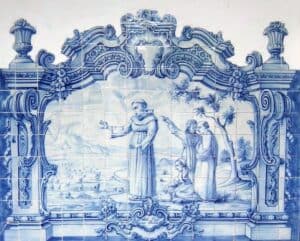Get to know who was St Anthony and how to identify him.
In this post learn how to identify the representations of St Anthony by his attributes.
Cover image: Sermon of Saint Anthony to the Fishes, tile panel, Guimarães, Portugal.
Learn how to apply methods of iconographic analysis and recognise symbols and attributes of the Saints, through practical exercises and other resources for future use.
Online course - Iconography of the Saints.
Who was St Anthony

St Anthony of Lisbon (or Padua) was a doctor of the church who lived at the turn of sec. XII for sec. XIII.
He was born in Lisbon in 1195 and died in Padua in 1231.
Having belonged initially to the order of Santa Cruz, he embraced the franciscan rule in 1220.
He traveled through France and Italy and was an important theologian, orator, and thaumaturge.
He left writings attesting to his great culture and was a noted preacher.
Identification of characters and episodes in works of art
In the context of Art History , the careful description and interpretation of artistic objects allows us to see something more than what is immediately presented.
see something more than what is immediately presented.
The use of attributes (associated objects or symbols) came alongside a need to identify the religious characters before a mostly illiterate audience.
In the beginning, we can still find the names of the Saints painted on their halo or on the filacterium (a silk band that usually carries a message and can be across the chest, at the bottom of the figure).
However, the use of signs or symbols, as was tradition in pagan religions, proved much more efficient, having been more accepted over time.
The Saint was this way singled out by his/hers physical aspect, clothing, weaponry, accompanying animals or other symbols related to their life story.
We can distinguish a Saint by two aspects:
– their characteristics – referring to physical appearance and clothing;
– their attributes – the elements of various kinds that generally relate to their condition, occupation, life history or martyrdom.